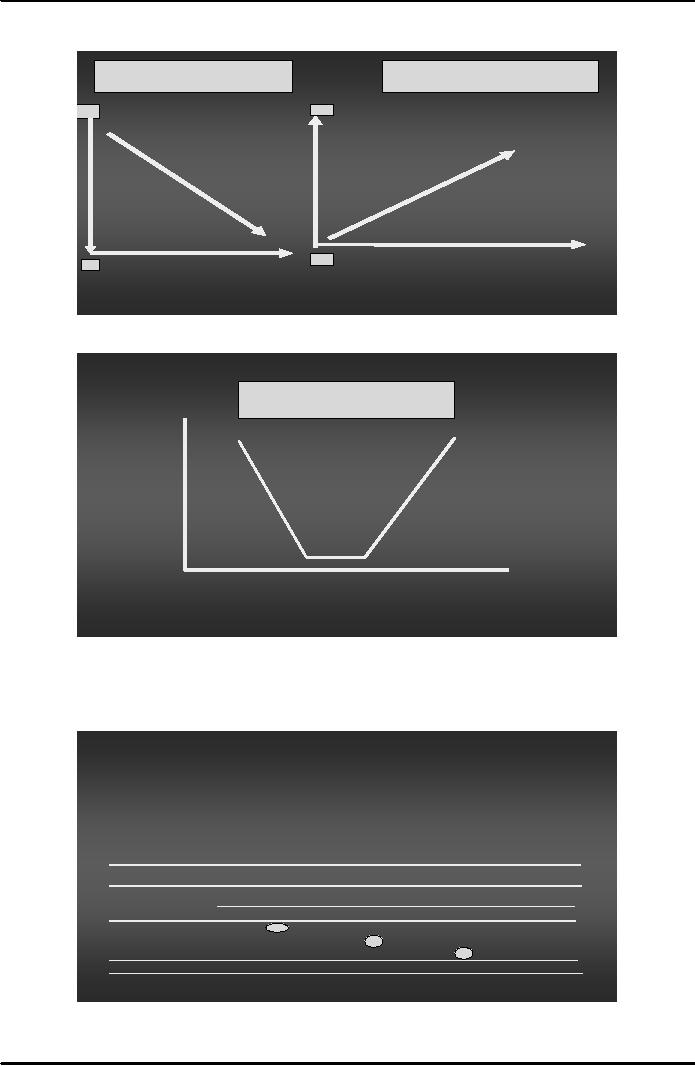 |
THE PARTS OF THE TABLE:Reading a percentage Table |
| << DATA PRESENTATION:Bivariate Tables, Constructing Percentage Tables |
| EXPERIMENTAL RESEARCH:The Language of Experiments >> |

Research
Methods STA630
VU
Lesson
32
THE
PARTS OF THE
TABLE
1.
Give
each table a number.
2.
Give
each table a title, which
names variables and provides
background information
3.
Label
the row and columns variables and give
name to each of the variable
categories.
4.
Include
the totals of the columns and rows.
These are called
marginals.They
equal the
univariate
frequency distribution for the
variable.
5.
Each
number or place that corresponds to the
intersection of a category for each
variable is a
cell
of a table.
6.
The
numbers with the labeled
variable categories and the totals
are called the body
of the table.
7.
If there is
missing information, report the number of missing
cases near the table to
account for
all
original cases.
Researchers
convert raw count tables
into percentages to see
bi-variate relationship. There are
three
ways
to percentage a table: by row, by
column, and for the total.
The first two are
often used and show
relationship.
Is
it best to percentage by row or
column? Either could be
appropriate. A researcher's hypothesis
may
imply
looking at row percentages or the
column percentages. Here, the hypothesis
is that age affects
attitude,
so column percentages are
most helpful. Whenever one
factor in a cross-tabulation can
be
considered
the cause of the other, percentage
will be most illuminating if
they are computed in the
direction
of the causal factor.
Reading
a percentage Table: Once
we understand how table is made,
reading it and figuring out
what
it
says are much easier. To
read a table, first look at
the title, the variable labels, and
any background
information.
Next, look at the direction in
which percentages have been computed
in rows or
columns.
Researchers
read percentaged tables to make
comparisons. Comparisons are made in the
opposite
direction
from that in which
percentages are computed. A rule of
thumb is to compare across rows if
the
table
is percentaged down (i.e. by
column) and to compare up and
down in columns if the table
is
percentaged
across (i.e. by row).
It
takes practice to see a relationship in a
perentaged table. If there is no relationship in a
table, the cell
percentages
look approximately equal
across rows or columns. A linear
relationship looks like
larger
percentages
in the diagonal cells. If there is curvilinear
relationship, the largest percentages
form a
pattern
across cells. For example, the largest
cells might be the upper right, the
bottom middle, and the
upper
left. It is easiest to see a
relationship in a moderate-sized table (9 to 16
cells) where most
cells
have
some cases (at least
five cases are recommended) and the
relationship is strong and
precise.
Linear
relationship
·
Table 4: Age by attitude towards women
.
empowerment
.
Age
(in years)
.
Level
of
under
40
40
60
61
+
Total
attitude
F.
%
F.
%
F
%
F
%
Hi
Favorable
600
60
300
30
200
20
1100
37
Med.
Favorable 300
30
500
50
250
25
1050
28
Lo
Favorable
100
10
200
20
500
50
850
28
Total
1000
100
1000
100
1000
100
3000
100
·
Larger
percentages in the diagonal cells
107

Research
Methods STA630
VU
Linear
Linear
Negative
relationship
Positive
relationship
Y
Y
X
X
Curvilinear
A
simple way to see strong
relationships is to circle the largest
percentage in each row (in
row
percentaged
tables) or columns (for column-percentaged tables) and
see if a line
appears.
A
simple way to see strong relationship is to
circle
the largest percentage in applicable
row
or column and see if a line appears
·
Table 4: Age by attitude towards women
.
empowerment
.
Age
(in years)
.
Level
of
under
40
40
60
61
+
Total
attitude
F.
%
F.
%
F
%
F
%
60
Hi
Favorable
600
60
300
30
200
20
1100
37
50
Med.
Favorable 300
30
500
250
25
1050
35
50
Lo
Favorable
100
10
200
20
500
850
28
Total
1000
100
1000
100
1000
100
3000
100
108

Research
Methods STA630
VU
The
circle-the-largest-cell rule works
with one important caveat.
The categories in the
percentages
table
must be ordinal or interval.
The lowest variable
categories begin at the
bottom left. If the
categories
in a table are not ordered the
same way, the rule does
not work.
Statistical
Control
Showing
an association or relationship between two
variables is not sufficient to
say that an
independent
variable
causes
a
dependent variable. In addition to
temporal order and association, a
researcher must
eliminate
alternative explanations
explanations that can make the
hypothetical relationship
spurious.
Experimental
researchers do this by choosing a
research design that physically
controls potential
alternative
explanations for results
(i.e. that threaten internal
validity).
In
non-experimental research, a researcher
controls for alternative
explanations with statistics. He
or
she
measures possible alternative
explanations with control
variables, and
then examines the
control
variables
with multivariate tables and
statistics that help him or
her to decide whether a bivariate
relationship
is spurious. They also show the relative
size of the effect of multiple
independent variables
on
dependent variable.
A
researcher controls for
alternative explanation in multivariate
(more than two variables) analysis
by
introducing
a third (sometimes fourth, or
fifth) variable. For
example, a bivariate table
shows that
young
people show more favorable attitude
towards women empowerment. But the
relationship
between
age and attitude towards women
empowerment may be spurious because men
and women may
have
different attitudes. To test
whether the relationship is actually due
to gender, a researcher
must
control
for gender; in other words, effects of gender
are statistically removed. Once
this is done, a
researcher
can see whether the
bivariate relationship between age and
attitude towards women
empowerment
remains.
A
researcher controls for a
third variable by seeing
whether the bivariate relationship
persists within
categories
of the control variable. For
example controls for gender,
and the relationship between age
and
attitude persists. This
means that both male and
females show negative association between
age
and
attitude toward women empowerment. In
other words, the control variable
has no effect. When
this
is so, the bivariate relationship is
not spurious.
If
the bivariate relationship weakens or
disappears after the control
variable is considered, it means
that
the
age is not real factor
that makes the difference in
attitude towards women empowerment,
rather it is
the
gender of the respondents.
Statistical
control is a key idea in
advanced statistical techniques. A
measure of association like the
correlation
co-efficient only suggests a
relationship. Until a researcher
considers control variables,
the
bivariate
relationship could be spurious.
Researchers are cautious in interpreting
bivariate relationships
until
they have considered control
variables.
After
they introduce control
variables, researchers talk
about the net
effect of an
independent variable
the
effect of independent variable
"net of," or in spite of, the
control variable. There are
two ways to
introduce
control variables: trivariate
percentaged tables and multiple
regression analysis.
Constructing
Trivariate Tables
In
order to meet all the
conditions needed for
causality, researchers want to
"control for" or see
whether
an
alternative explanation explains
away a causal relationship. If an
alternative explanation explains
a
relationship,
then bivariate relationship is spurious.
Alternative explanations are
operationalize as a
third
variable, which are called
control
variables because
they control for alternative
explanation.
109

Research
Methods STA630
VU
One
way to take such third
variables into consideration and
see whether they influence
the bivariate
relationship
is to statistically introduce control
variables using trivariate or three
variable tables.
Trivariate
tables differ slightly from
bivariate tables; they consist of
multiple bivariate tables.
A
trivariate table has a
bivariate table of the independent and
dependent variable for each
category of
the
control variable. These new
tables are called partials.
The
number of partials depends on the
number
of categories in control variable.
Partial tables look like
bivariate tables, but they
use a subset
of
the cases. Only cases with a
specific value on the control
variable are in the partial. Thus it
is
possible
to break apart a bivariate table to
form partials, or combine the
partials to restore the
initial
bivariate
table.
Trivariate
tables have three limitations. First,
they are difficult to
interpret if a control variable
has more
that
four categories. Second, control
variables can be at any
level of measurement, but
interval or ratio
control
variables must be grouped
(i.e. converted to an ordinal
level), and how cases
are grouped can
affect
the interpretation of effects. Finally, the
total number of cases is a limiting
factor because the
cases
are divided among cells in partials.
The number of cells in the partials
equals the number of cells
in
the bivariate relationship multiplied by
the number of categories in the control
variables. For
example
if
the control variable has three
categories, and a bivariate table
has 12 cells, the partials have 3 X 12
=
36
cells. An average of five cases per
cell is recommended, so the researcher
will need 5 X 36 =
180
cases
at minimum.
Like
a bivariate table construction, a
trivariate table begins with a compound
frequency distribution
(CFD),
but it is a three-way instead of two-way
CFD. An example of a trivariate
table with "gender"
as
control
variable for the bivariate
table is shown here:
Partial
table for males
.
.
·
.
Age
(in years)
.
·
Level
of
.
Under
40
40--60
61+
Total
.
·
Attitude
F
%
F
%
F.
%
F.
%.
·
High
300
60
200
33
30
6
530
33
·
Medium
140
28
270
45
120
24
530
33
·
Low
60
12
130
22
350
70
540
34
·
Total
500
100
600
100
500
100 1600
100
Partial
table for females
.
.
·
.
Age
(in years)
.
·
Level
of
.Under
40
40--60
61+
Total
.
·
Attitude
F
%
F
%
F.
%
F.
%.
·
High
350
70
200
50
20
4
570
41
·
Medium
150
30
150
38
220
44
520
37
·
Low
-
-
50
12
260
52
310
22
·
Total
500
100
400
100
500
100
1400
100
The
replication pattern is the
easiest to understand. It is when the
partials replicate or reproduce
the
same
relationship that existed in the
bivariate table before
considering the control variable. It
means
that
the control variable has no
effect.
110

Research
Methods STA630
VU
The
specification pattern is the
next easiest pattern. It
occurs when one partial
replicate the initial
bivariate
relationship but other
partials do not. For
example, we find a strong (negative)
bivariate
relationship
between age of the respondents and
attitude towards women empowerment. We
control for
gender
and discover the relationship holds
only for males (i.e. the
strong negative relationship was in
the
partial
for males, but not
for females). This is specification
because a researcher can
specify the
category
of the control variable in which the
initial relationship
persists.
The
interpretation pattern describes the
situation in which the control
variable intervenes between the
original
independent variable and the dependent
variables.
The
suppressor variable pattern
occurs
when the bivariate tables
suggest independence but
relationship
appears
in one or both of the partials.
For example, the age of the
respondents and their
attitudes
towards
women empowerment are independent in a
bivariate table. Once the
control variable
"gender"
is
introduced, the relationship between the
two variables appears in the
partial tables. The
control
variable
is suppressor variable because it
suppressed the true relationship; the
true relationship
appears
in
partials.
Multiple
Regression Analysis
Multiple
regression controls for many
alternative explanations of variables
simultaneously (it is
rarely
possible
to use more than one control
variable using percentaged tables).
Multiple regression is a
technique
whose calculation you may
have learnt in the course on
statistics.
Note
In
the preceding discussion you have
been exposed to the descriptive analysis
of the data. Certainly
there
are statistical tests which
can be applied to test the hypothesis,
which you may have learnt in
your
course
on statistics.
111
Table of Contents:
- INTRODUCTION, DEFINITION & VALUE OF RESEARCH
- SCIENTIFIC METHOD OF RESEARCH & ITS SPECIAL FEATURES
- CLASSIFICATION OF RESEARCH:Goals of Exploratory Research
- THEORY AND RESEARCH:Concepts, Propositions, Role of Theory
- CONCEPTS:Concepts are an Abstraction of Reality, Sources of Concepts
- VARIABLES AND TYPES OF VARIABLES:Moderating Variables
- HYPOTHESIS TESTING & CHARACTERISTICS:Correlational hypotheses
- REVIEW OF LITERATURE:Where to find the Research Literature
- CONDUCTING A SYSTEMATIC LITERATURE REVIEW:Write the Review
- THEORETICAL FRAMEWORK:Make an inventory of variables
- PROBLEM DEFINITION AND RESEARCH PROPOSAL:Problem Definition
- THE RESEARCH PROCESS:Broad Problem Area, Theoretical Framework
- ETHICAL ISSUES IN RESEARCH:Ethical Treatment of Participants
- ETHICAL ISSUES IN RESEARCH (Cont):Debriefing, Rights to Privacy
- MEASUREMENT OF CONCEPTS:Conceptualization
- MEASUREMENT OF CONCEPTS (CONTINUED):Operationalization
- MEASUREMENT OF CONCEPTS (CONTINUED):Scales and Indexes
- CRITERIA FOR GOOD MEASUREMENT:Convergent Validity
- RESEARCH DESIGN:Purpose of the Study, Steps in Conducting a Survey
- SURVEY RESEARCH:CHOOSING A COMMUNICATION MEDIA
- INTERCEPT INTERVIEWS IN MALLS AND OTHER HIGH-TRAFFIC AREAS
- SELF ADMINISTERED QUESTIONNAIRES (CONTINUED):Interesting Questions
- TOOLS FOR DATA COLLECTION:Guidelines for Questionnaire Design
- PILOT TESTING OF THE QUESTIONNAIRE:Discovering errors in the instrument
- INTERVIEWING:The Role of the Interviewer, Terminating the Interview
- SAMPLE AND SAMPLING TERMINOLOGY:Saves Cost, Labor, and Time
- PROBABILITY AND NON-PROBABILITY SAMPLING:Convenience Sampling
- TYPES OF PROBABILITY SAMPLING:Systematic Random Sample
- DATA ANALYSIS:Information, Editing, Editing for Consistency
- DATA TRANSFROMATION:Indexes and Scales, Scoring and Score Index
- DATA PRESENTATION:Bivariate Tables, Constructing Percentage Tables
- THE PARTS OF THE TABLE:Reading a percentage Table
- EXPERIMENTAL RESEARCH:The Language of Experiments
- EXPERIMENTAL RESEARCH (Cont.):True Experimental Designs
- EXPERIMENTAL RESEARCH (Cont.):Validity in Experiments
- NON-REACTIVE RESEARCH:Recording and Documentation
- USE OF SECONDARY DATA:Advantages, Disadvantages, Secondary Survey Data
- OBSERVATION STUDIES/FIELD RESEARCH:Logic of Field Research
- OBSERVATION STUDIES (Contd.):Ethical Dilemmas of Field research
- HISTORICAL COMPARATIVE RESEARCH:Similarities to Field Research
- HISTORICAL-COMPARATIVE RESEARCH (Contd.):Locating Evidence
- FOCUS GROUP DISCUSSION:The Purpose of FGD, Formal Focus Groups
- FOCUS GROUP DISCUSSION (Contd.):Uses of Focus Group Discussions
- REPORT WRITING:Conclusions and recommendations, Appended Parts
- REFERENCING:Book by a single author, Edited book, Doctoral Dissertation